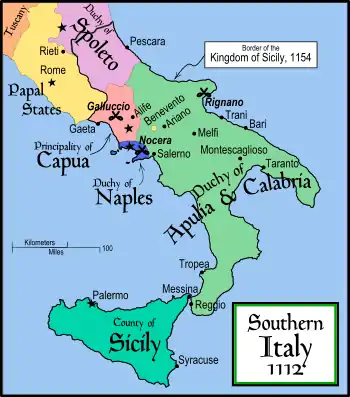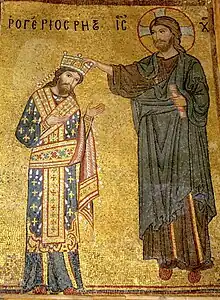County of Sicily | |||||||||
|---|---|---|---|---|---|---|---|---|---|
| 1071–1130 | |||||||||
 The county in 1112, before its merger with the mainland Duchy of Apulia and Calabria | |||||||||
| Capital | Palermo 38°7′N 13°21′E / 38.117°N 13.350°E | ||||||||
| Common languages | Latin, Norman, Byzantine Greek, Siculo-Arabic, and Hebrew | ||||||||
| Religion | Roman Catholicism (official), Greek Orthodoxy, Islam, and Judaism | ||||||||
| Government | Monarchy | ||||||||
| Count | |||||||||
• 1071–1101 | Roger I | ||||||||
• 1101–1105 | Simon | ||||||||
• 1105–1130 | Roger II | ||||||||
| History | |||||||||
• Established | 1071 | ||||||||
• Disestablished | 1130 | ||||||||
| |||||||||
| Today part of | Italy Malta | ||||||||
The County of Sicily, also known as County of Sicily and Calabria,[1][2] was a Norman state comprising the islands of Sicily and Malta and part of Calabria from 1071 until 1130.[3] The county began to form during the Christian reconquest of Sicily (1061–91) from the Muslim Emirate, established by conquest in 965. The county is thus a transitional period in the history of Sicily. After the Muslims had been defeated and either forced out or incorporated into the Norman military, a further period of transition took place for the county and the Sicilians.
History
The County of Sicily was created by Robert Guiscard in 1071 for his younger brother Roger Bosso. Guiscard himself had received the title Duke of Sicily (dux Siciliae) in 1059 from Pope Nicholas II as encouragement to conquer it from the Muslims. In 1061 the first permanent Norman conquest (Messina) was made and in 1071, after the fall of Palermo, the capital of the emirate and future capital of the county, Guiscard invested Roger with the title of count and gave him full jurisdiction in the island save for half the city of Palermo, Messina, and the Val Demone, which he retained for himself. Roger was to hold the county which comprised conquests yet to be made under Guiscard. In February 1091 the conquest of Sicily was completed when Noto fell. The conquest of Malta was begun later that year; it was completed in 1127 when the Arab administration of the island was expelled.
Robert Guiscard left Roger in an ambiguous relationship with his successors of the Duchy of Apulia and Calabria. After the death of Robert in 1085, Roger I obtained from the new duke, Roger Borsa, the whole rights over the castles in Calabria, the lordship of which he had previously shared with Robert Guiscard.[4] In fact, the seat of Roger I's government was the Calabrian town of Mileto.[5] According to historians Agostino Inveges and Matteo Camera, Roger I started to use the title "Great Count of Sicily and Calabria" since 1096.[6] After the death of Roger I the major change was the transfer of the capital: Palermo became the capital in 1112, when Roger II was invested with the county, after the regency of the mother Adelaide del Vasto.[7] With this change, Sicily come to be governed by the central government, while the Calabrian territories became a provincial administrative unit.[8] During the reigns of Roger II of Sicily and William II of Apulia conflict broke out between the two Norman principalities, first cousins through Roger and Robert respectively. Through the mediation of Pope Calistus II and in return for aid against a rebellion led by Jordan of Ariano in 1121, the childless William ceded all his Sicilian territories to Roger and named him his heir.
When William died in 1127, Roger inherited the mainland duchy; three years later, in 1130 in Palermo, he merged his holdings to form the Kingdom of Sicily with the approval of antipope Anacletus II.
List of counts
Sicily was granted, pending its Christian reconquest, to Robert Guiscard as "duke" in 1059 by Pope Nicholas II. Guiscard granted it as a county to his brother Roger.
| Count | Portrait | Birth | Marriages | Death |
|---|---|---|---|---|
| Roger I 1071–1101 | 1031 son of Tancred of Hauteville and Fredisenda | Judith of Évreux 1061 4 children Eremburga of Mortain 1077 8 children Adelaide del Vasto 1087 4 children | 1101 Mileto aged 70 | |
| Simon 1101–1105 | 1093 son of Roger I of Sicily and Adelaide del Vasto | never married | 1105 Mileto aged 12 | |
| Roger II 1105–1130 |  | 22 December 1095 Mileto son of Roger I of Sicily and Adelaide del Vasto | Elvira of Castile 1117 6 children Sibyl of Burgundy 1149 2 children Beatrix of Rethel 1151 1 child | 26 February 1154 Palermo aged 59 |
See also
References
- ↑ Fiore, Giovanni. Della Calabria illustrata, Vol. 3. Rubbettino, 1999. p. 551.
- ↑ Roger I, Encyclopædia Britannica: "Roger went to Italy in 1057 to aid his brother Robert Guiscard in his conquest of Calabria from the Byzantines (1060). They began the conquest of Sicily from various Muslim rulers in 1061 with the capture of Messina, and they completed it in 1091. The turning point of the struggle was the capture of Palermo in 1072, when Robert invested Roger as his vassal with the county of Sicily and Calabria with a limited right to govern and to tax."
- ↑ Takayama, Hiroshi. The Administration of the Norman Kingdom of Sicily. Brill Publishers: Leiden, 1993. p. 47.
- ↑ Takayama, p. 25.
- ↑ Takayama, p. 25.
- ↑ Camera, Matteo. Annali Delle Due Sicilie, Vol. I, 1841. p. 32.
- ↑ Takayama, p. 48.
- ↑ Takayama, p. 48.
